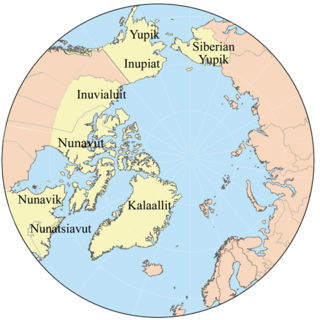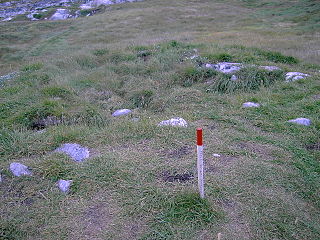Sources
- Murray, M.S. (2005). Prehistoric Use of Ringed Seals: A Zooarchaeological Study from Arctic Canada. Environmental Archaeology10 (1): 19–38.
The Early Paleo-Eskimo is the first of three distinct periods of human occupation recognized by archaeologists in the eastern North American Arctic, the others being the Late Paleo-Eskimo and the Thule. Dates for these occupations vary according to specific geographic region and cultural historical perspective, but it is generally agreed that the Early Paleo-Eskimo approximately spans the period from 4500 BP to 2800-2300 BP.
The Early Paleo-Eskimo tradition is known by a number of local, and sometimes spatially and temporally overlapping and related variants including the Independence I culture in the High Arctic and Greenland, Saqqaq culture in Greenland, Pre-Dorset in the High and Central Arctic and the Baffin/Ungava region and Groswater in Newfoundland and Labrador. More generally these are subsumed under a larger microlith tradition known as the Arctic Small Tool Tradition. Their ancestral origins are presumed to lie in Alaska, and ultimately Siberia and Eurasia.

Eskimo is an exonym used to refer to two closely related Indigenous peoples: the Inuit and the Yupik of eastern Siberia and Alaska. A related third group, the Aleut, which inhabit the Aleutian Islands, are generally excluded from the definition of Eskimo. The three groups share a relatively recent common ancestor, and speak related languages belonging to the Eskimo–Aleut language family.
The Thule or proto-Inuit were the ancestors of all modern Inuit. They developed in coastal Alaska by the year 1000 and expanded eastward across northern Canada, reaching Greenland by the 13th century. In the process, they replaced people of the earlier Dorset culture that had previously inhabited the region. The appellation "Thule" originates from the location of Thule in northwest Greenland, facing Canada, where the archaeological remains of the people were first found at Comer's Midden. The links between the Thule and the Inuit are biological, cultural, and linguistic.
The Paleo-Eskimo were the peoples who inhabited the Arctic region from Chukotka in present-day Russia across North America to Greenland prior to the arrival of the modern Inuit (Eskimo) and related cultures. The first known Paleo-Eskimo cultures developed by 2500 BCE, but were gradually displaced in most of the region, with the last one, the Dorset culture, disappearing around 1500 CE.

The Greenland Dog is a large breed of husky-type dog kept as a sled dog. They were brought from Siberia to North America by the Thule people 1,000 years ago, along with the Canadian Eskimo Dog. The Canadian Eskimo Dog is considered the same breed as the Greenland Dog since they have not yet diverged enough genetically to be considered separate breeds, despite their geographic isolation.

The Saqqaq culture was a Paleo-Eskimo culture in southern Greenland. Up to this day, no other people seem to have lived in Greenland continually for as long as the Saqqaq.
The Arctic Small Tool tradition (ASTt) was a broad cultural entity that developed along the Alaska Peninsula, around Bristol Bay, and on the eastern shores of the Bering Strait around 2500 BC. ASTt groups were the first human occupants of Arctic Canada and Greenland. This was a terrestrial entity that had a highly distinctive toolkit based on microblade technology. Typically tool types include scrapers, burins and side and end blades used in composite arrows or spears made of other materials, such as bone or antler. Many researchers also assume that it was Arctic Small Tool populations who first introduced the bow and arrow to the Arctic, that eventually became the Eskimo archery material culture. ASTt camps are often found along coasts and streams, to take advantage of seal or salmon populations. While some of the groups were fairly nomadic, more permanent, sod-roofed homes have also been identified from Arctic Small Tool tradition sites.

Peary Land is a peninsula in northern Greenland, extending into the Arctic Ocean. It reaches from Victoria Fjord in the west to Independence Fjord in the south and southeast, and to the Arctic Ocean in the north, with Cape Morris Jesup, the northernmost point of Greenland's mainland, and Cape Bridgman in the northeast.
The Paleo-Arctic Tradition is the name given by archaeologists to the cultural tradition of the earliest well-documented human occupants of the North American Arctic, which date from the period 8000–5000 BC. The tradition covers Alaska and expands far into the east, west, and the Southwest Yukon Territory.

Masks among Eskimo peoples served a variety of functions. Masks were made out of driftwood, animal skins, bones and feathers. They were often painted using bright colors. There are archeological miniature maskettes made of walrus ivory, dating from early Paleo-Eskimo and from early Dorset culture period.

Independence I was a culture of Paleo-Eskimos who lived in northern Greenland and the Canadian Arctic between 2400 and 1900 BC. There has been much debate among scholars on when Independence I culture disappeared, and, therefore, there is a margin of uncertainty with the dates.
Based on archeological finds, Brooman Point Village is an abandoned village in Qikiqtaaluk Region, Nunavut, Canada. It is located in the central High Arctic on a point of the Gregory Peninsula, part of the eastern coast of Bathurst Island. Brooman was both a Late Dorset culture Paleo-Eskimo village as well as an Early Thule culture village. Both the artifacts and the architecture, specifically longhouses, are considered important historical remains of the two cultures. The site shows traces of Palaeo-Eskimo occupations between about 2000 BC and 1 AD, but the major prehistoric settlement occurred from about 900 to 1200 AD.

Circumpolar peoples and Arctic peoples are umbrella terms for the various Indigenous peoples of the Arctic.

Inuit are a group of culturally similar indigenous peoples inhabiting the Arctic and subarctic regions of Greenland, Labrador, Quebec, Nunavut, the Northwest Territories, and Alaska. Inuit languages are part of the Eskimo–Aleut languages, also known as Inuit-Yupik-Unangan, and also as Eskaleut. Inuit Sign Language is a critically endangered language isolate used in Nunavut.
McDougall Sound is an Arctic waterway in Qikiqtaaluk, Nunavut, Canada. It is located between southeastern Bathurst Island and western Cornwallis island. The sound's southern mouth opens to the Parry Channel, and beyond that, to the Barrow Strait. The sound's northern mouth opens to Crozier Strait. The sound is populated by several smaller islands, the named ones including Milne Island, Little Cornwallis Island, Wood Island, Neal Islands, Truro Island, and Baker Island.
Comer's Midden was a 1916 archaeological excavation site near Thule, north of Mt. Dundas in North Star Bay in northern Greenland. It is the find after which the Thule culture was named. The site was first excavated in 1916 by whaling Captain George Comer, ice master of the Crocker Land Expedition's relief team, and of members of Knud Rasmussen's Second Danish Thule Expedition who were in the area charting the North Greenland coast.

Therkel Mathiassen was an archaeologist, anthropologist, cartographer, and ethnographer notable for his scientific study of the Arctic.

The Inuit are an indigenous people of the Arctic and subarctic regions of North America. The ancestors of the present-day Inuit are culturally related to Iñupiat, and Yupik, and the Aleut who live in the Aleutian Islands of Siberia and Alaska. The term culture of the Inuit, therefore, refers primarily to these areas; however, parallels to other Eskimo groups can also be drawn.

The qulliq, is the traditional oil lamp used by Arctic peoples, including the Inuit, the Chukchi and the Yupik peoples.
The Pre-Dorset is a loosely defined term for a Paleo-Eskimo culture or group of cultures that existed in the Eastern Canadian Arctic from c. 3200 to 850 cal BC, and preceded the Dorset culture.
Port Refuge is located off the south coast of Grinnell Peninsula in a small bay on the south coast of Devon Island in Nunavut, Canada. The site received its current name by Sir Edward Belcher when he sought refuge there in 1852-1853 from moving ice during his voyage in search of the missing Franklin Expedition.